Anthropometric Audit of a Car: Designing for Human Factors
VerifiedAdded on 2023/06/15
|15
|2254
|230
AI Summary
This report collects numerical data on the physical characteristics of a human being in the design of a car with reference to the flight deck design. It covers the principles of Human-focused design as applied to the flight deck, human factors at the various stages of the design process, and more.
Contribute Materials
Your contribution can guide someone’s learning journey. Share your
documents today.
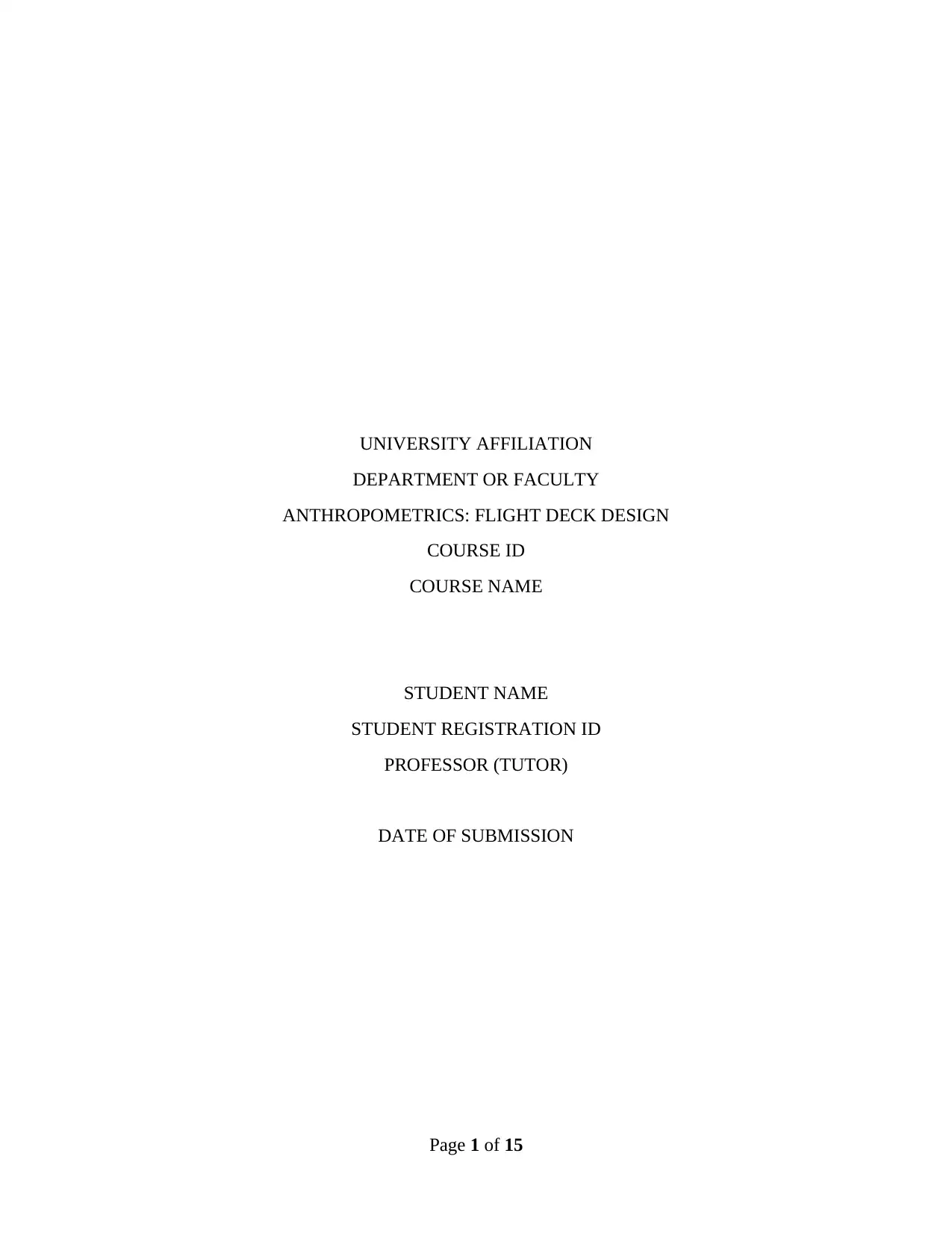
UNIVERSITY AFFILIATION
DEPARTMENT OR FACULTY
ANTHROPOMETRICS: FLIGHT DECK DESIGN
COURSE ID
COURSE NAME
STUDENT NAME
STUDENT REGISTRATION ID
PROFESSOR (TUTOR)
DATE OF SUBMISSION
Page 1 of 15
DEPARTMENT OR FACULTY
ANTHROPOMETRICS: FLIGHT DECK DESIGN
COURSE ID
COURSE NAME
STUDENT NAME
STUDENT REGISTRATION ID
PROFESSOR (TUTOR)
DATE OF SUBMISSION
Page 1 of 15
Secure Best Marks with AI Grader
Need help grading? Try our AI Grader for instant feedback on your assignments.
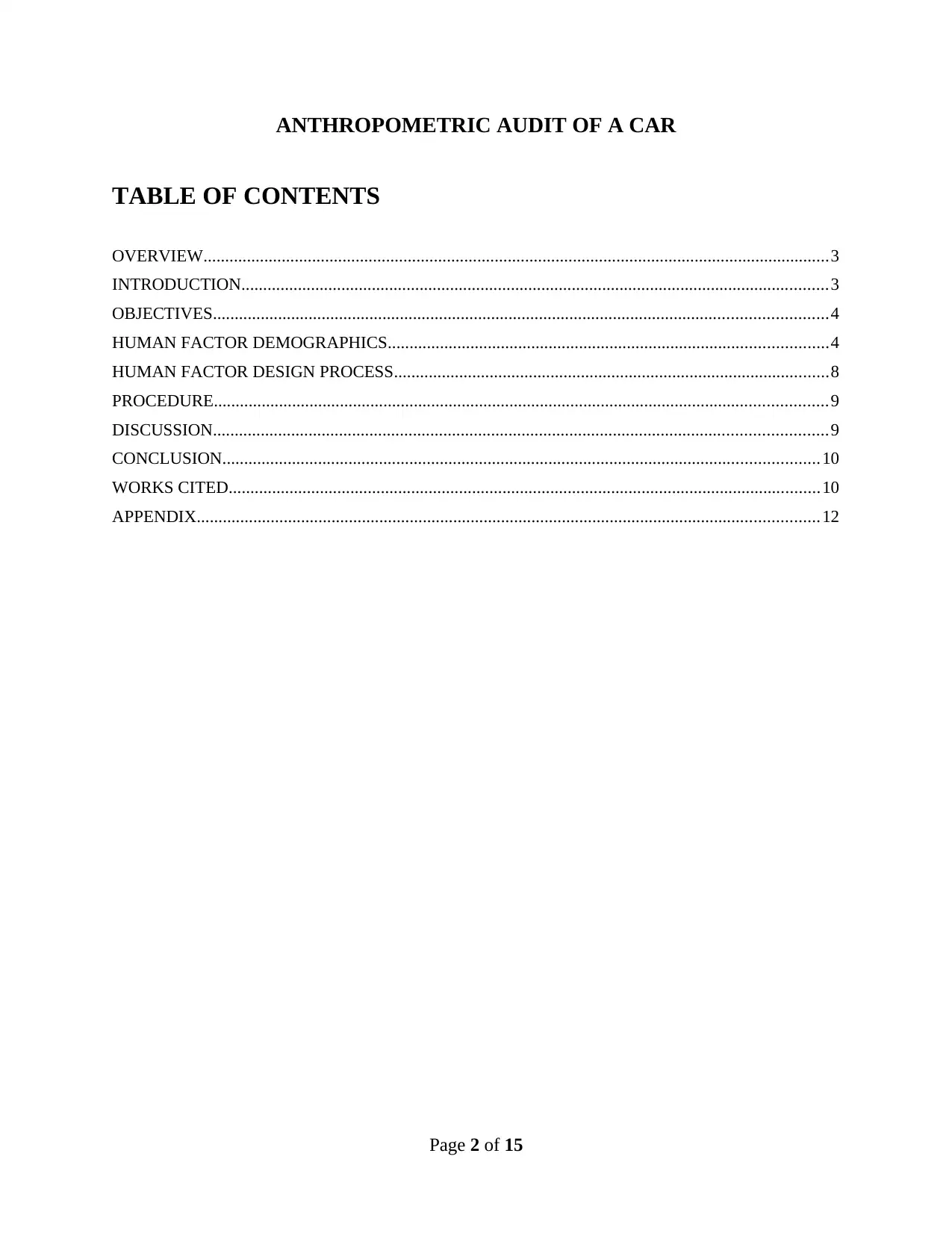
ANTHROPOMETRIC AUDIT OF A CAR
TABLE OF CONTENTS
OVERVIEW................................................................................................................................................3
INTRODUCTION.......................................................................................................................................3
OBJECTIVES.............................................................................................................................................4
HUMAN FACTOR DEMOGRAPHICS.....................................................................................................4
HUMAN FACTOR DESIGN PROCESS....................................................................................................8
PROCEDURE.............................................................................................................................................9
DISCUSSION.............................................................................................................................................9
CONCLUSION.........................................................................................................................................10
WORKS CITED........................................................................................................................................10
APPENDIX...............................................................................................................................................12
Page 2 of 15
TABLE OF CONTENTS
OVERVIEW................................................................................................................................................3
INTRODUCTION.......................................................................................................................................3
OBJECTIVES.............................................................................................................................................4
HUMAN FACTOR DEMOGRAPHICS.....................................................................................................4
HUMAN FACTOR DESIGN PROCESS....................................................................................................8
PROCEDURE.............................................................................................................................................9
DISCUSSION.............................................................................................................................................9
CONCLUSION.........................................................................................................................................10
WORKS CITED........................................................................................................................................10
APPENDIX...............................................................................................................................................12
Page 2 of 15
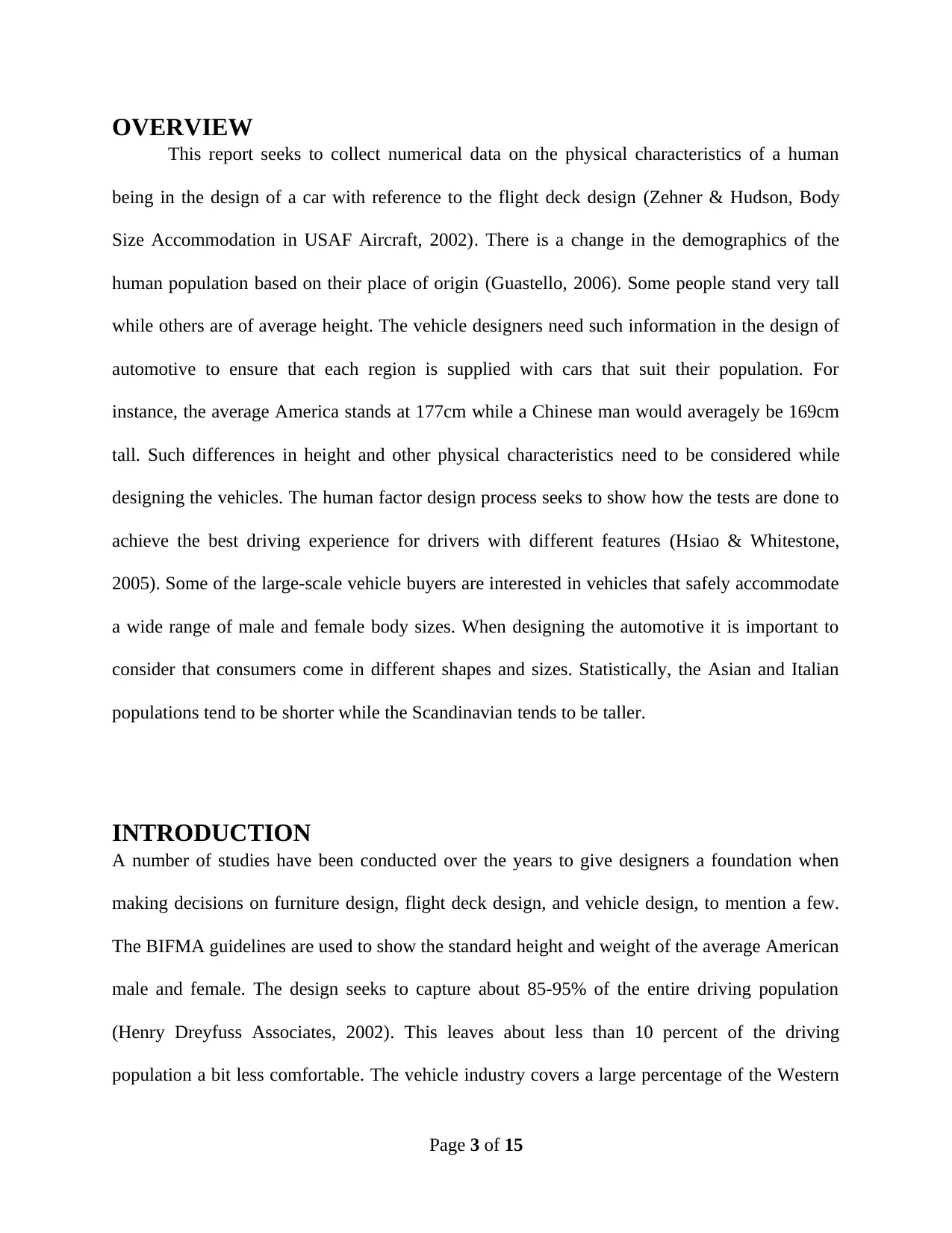
OVERVIEW
This report seeks to collect numerical data on the physical characteristics of a human
being in the design of a car with reference to the flight deck design (Zehner & Hudson, Body
Size Accommodation in USAF Aircraft, 2002). There is a change in the demographics of the
human population based on their place of origin (Guastello, 2006). Some people stand very tall
while others are of average height. The vehicle designers need such information in the design of
automotive to ensure that each region is supplied with cars that suit their population. For
instance, the average America stands at 177cm while a Chinese man would averagely be 169cm
tall. Such differences in height and other physical characteristics need to be considered while
designing the vehicles. The human factor design process seeks to show how the tests are done to
achieve the best driving experience for drivers with different features (Hsiao & Whitestone,
2005). Some of the large-scale vehicle buyers are interested in vehicles that safely accommodate
a wide range of male and female body sizes. When designing the automotive it is important to
consider that consumers come in different shapes and sizes. Statistically, the Asian and Italian
populations tend to be shorter while the Scandinavian tends to be taller.
INTRODUCTION
A number of studies have been conducted over the years to give designers a foundation when
making decisions on furniture design, flight deck design, and vehicle design, to mention a few.
The BIFMA guidelines are used to show the standard height and weight of the average American
male and female. The design seeks to capture about 85-95% of the entire driving population
(Henry Dreyfuss Associates, 2002). This leaves about less than 10 percent of the driving
population a bit less comfortable. The vehicle industry covers a large percentage of the Western
Page 3 of 15
This report seeks to collect numerical data on the physical characteristics of a human
being in the design of a car with reference to the flight deck design (Zehner & Hudson, Body
Size Accommodation in USAF Aircraft, 2002). There is a change in the demographics of the
human population based on their place of origin (Guastello, 2006). Some people stand very tall
while others are of average height. The vehicle designers need such information in the design of
automotive to ensure that each region is supplied with cars that suit their population. For
instance, the average America stands at 177cm while a Chinese man would averagely be 169cm
tall. Such differences in height and other physical characteristics need to be considered while
designing the vehicles. The human factor design process seeks to show how the tests are done to
achieve the best driving experience for drivers with different features (Hsiao & Whitestone,
2005). Some of the large-scale vehicle buyers are interested in vehicles that safely accommodate
a wide range of male and female body sizes. When designing the automotive it is important to
consider that consumers come in different shapes and sizes. Statistically, the Asian and Italian
populations tend to be shorter while the Scandinavian tends to be taller.
INTRODUCTION
A number of studies have been conducted over the years to give designers a foundation when
making decisions on furniture design, flight deck design, and vehicle design, to mention a few.
The BIFMA guidelines are used to show the standard height and weight of the average American
male and female. The design seeks to capture about 85-95% of the entire driving population
(Henry Dreyfuss Associates, 2002). This leaves about less than 10 percent of the driving
population a bit less comfortable. The vehicle industry covers a large percentage of the Western
Page 3 of 15
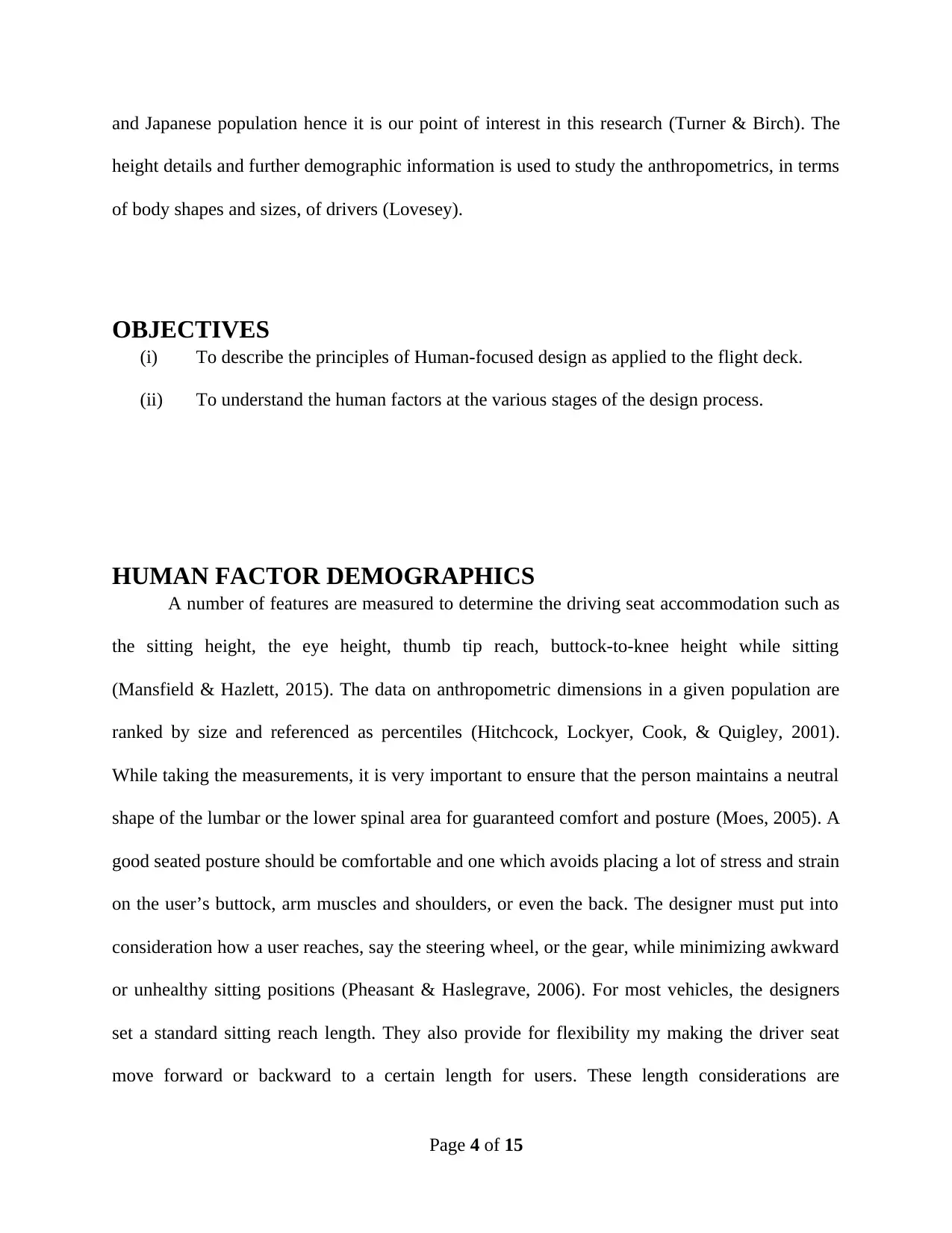
and Japanese population hence it is our point of interest in this research (Turner & Birch). The
height details and further demographic information is used to study the anthropometrics, in terms
of body shapes and sizes, of drivers (Lovesey).
OBJECTIVES
(i) To describe the principles of Human-focused design as applied to the flight deck.
(ii) To understand the human factors at the various stages of the design process.
HUMAN FACTOR DEMOGRAPHICS
A number of features are measured to determine the driving seat accommodation such as
the sitting height, the eye height, thumb tip reach, buttock-to-knee height while sitting
(Mansfield & Hazlett, 2015). The data on anthropometric dimensions in a given population are
ranked by size and referenced as percentiles (Hitchcock, Lockyer, Cook, & Quigley, 2001).
While taking the measurements, it is very important to ensure that the person maintains a neutral
shape of the lumbar or the lower spinal area for guaranteed comfort and posture (Moes, 2005). A
good seated posture should be comfortable and one which avoids placing a lot of stress and strain
on the user’s buttock, arm muscles and shoulders, or even the back. The designer must put into
consideration how a user reaches, say the steering wheel, or the gear, while minimizing awkward
or unhealthy sitting positions (Pheasant & Haslegrave, 2006). For most vehicles, the designers
set a standard sitting reach length. They also provide for flexibility my making the driver seat
move forward or backward to a certain length for users. These length considerations are
Page 4 of 15
height details and further demographic information is used to study the anthropometrics, in terms
of body shapes and sizes, of drivers (Lovesey).
OBJECTIVES
(i) To describe the principles of Human-focused design as applied to the flight deck.
(ii) To understand the human factors at the various stages of the design process.
HUMAN FACTOR DEMOGRAPHICS
A number of features are measured to determine the driving seat accommodation such as
the sitting height, the eye height, thumb tip reach, buttock-to-knee height while sitting
(Mansfield & Hazlett, 2015). The data on anthropometric dimensions in a given population are
ranked by size and referenced as percentiles (Hitchcock, Lockyer, Cook, & Quigley, 2001).
While taking the measurements, it is very important to ensure that the person maintains a neutral
shape of the lumbar or the lower spinal area for guaranteed comfort and posture (Moes, 2005). A
good seated posture should be comfortable and one which avoids placing a lot of stress and strain
on the user’s buttock, arm muscles and shoulders, or even the back. The designer must put into
consideration how a user reaches, say the steering wheel, or the gear, while minimizing awkward
or unhealthy sitting positions (Pheasant & Haslegrave, 2006). For most vehicles, the designers
set a standard sitting reach length. They also provide for flexibility my making the driver seat
move forward or backward to a certain length for users. These length considerations are
Page 4 of 15
Secure Best Marks with AI Grader
Need help grading? Try our AI Grader for instant feedback on your assignments.
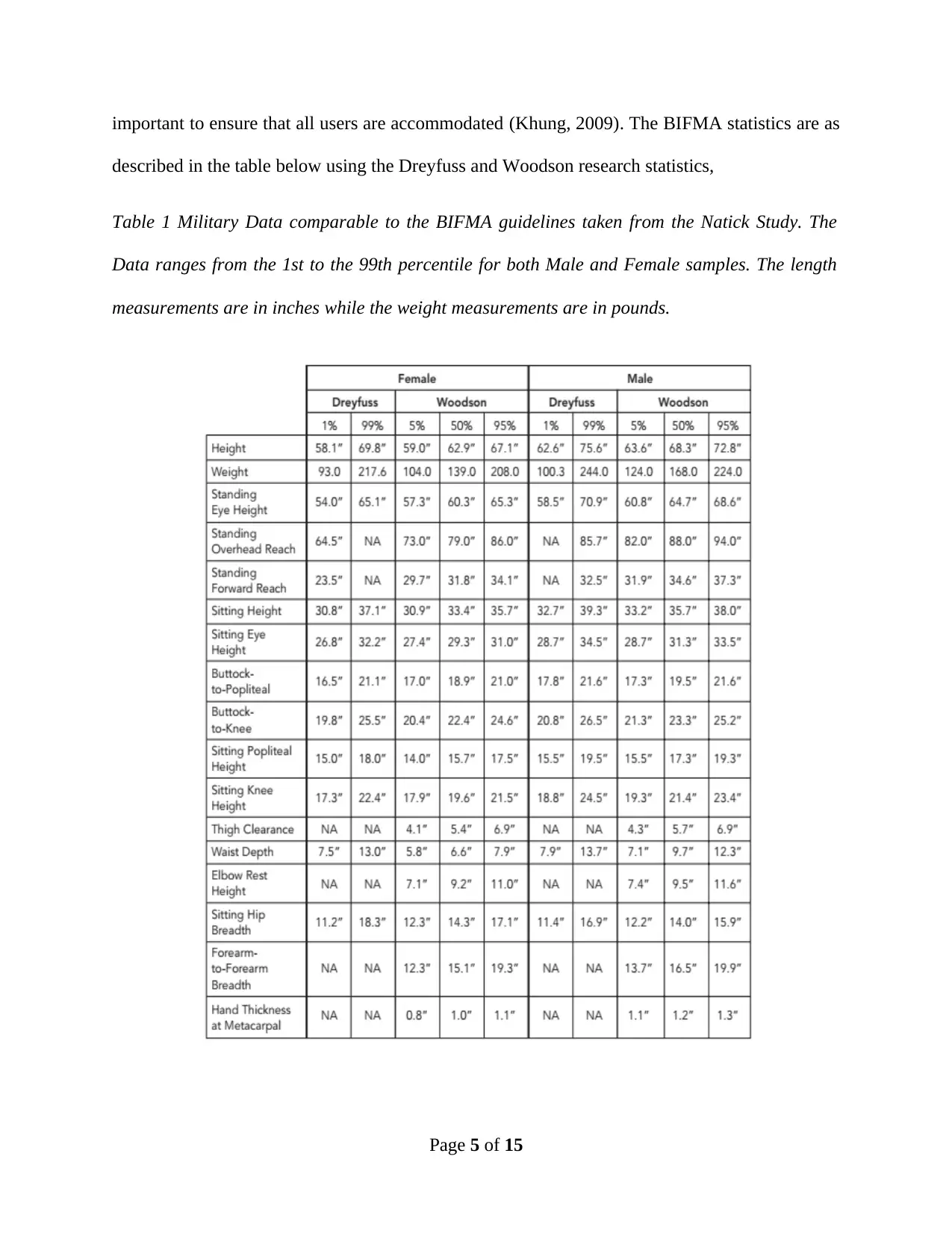
important to ensure that all users are accommodated (Khung, 2009). The BIFMA statistics are as
described in the table below using the Dreyfuss and Woodson research statistics,
Table 1 Military Data comparable to the BIFMA guidelines taken from the Natick Study. The
Data ranges from the 1st to the 99th percentile for both Male and Female samples. The length
measurements are in inches while the weight measurements are in pounds.
Page 5 of 15
described in the table below using the Dreyfuss and Woodson research statistics,
Table 1 Military Data comparable to the BIFMA guidelines taken from the Natick Study. The
Data ranges from the 1st to the 99th percentile for both Male and Female samples. The length
measurements are in inches while the weight measurements are in pounds.
Page 5 of 15
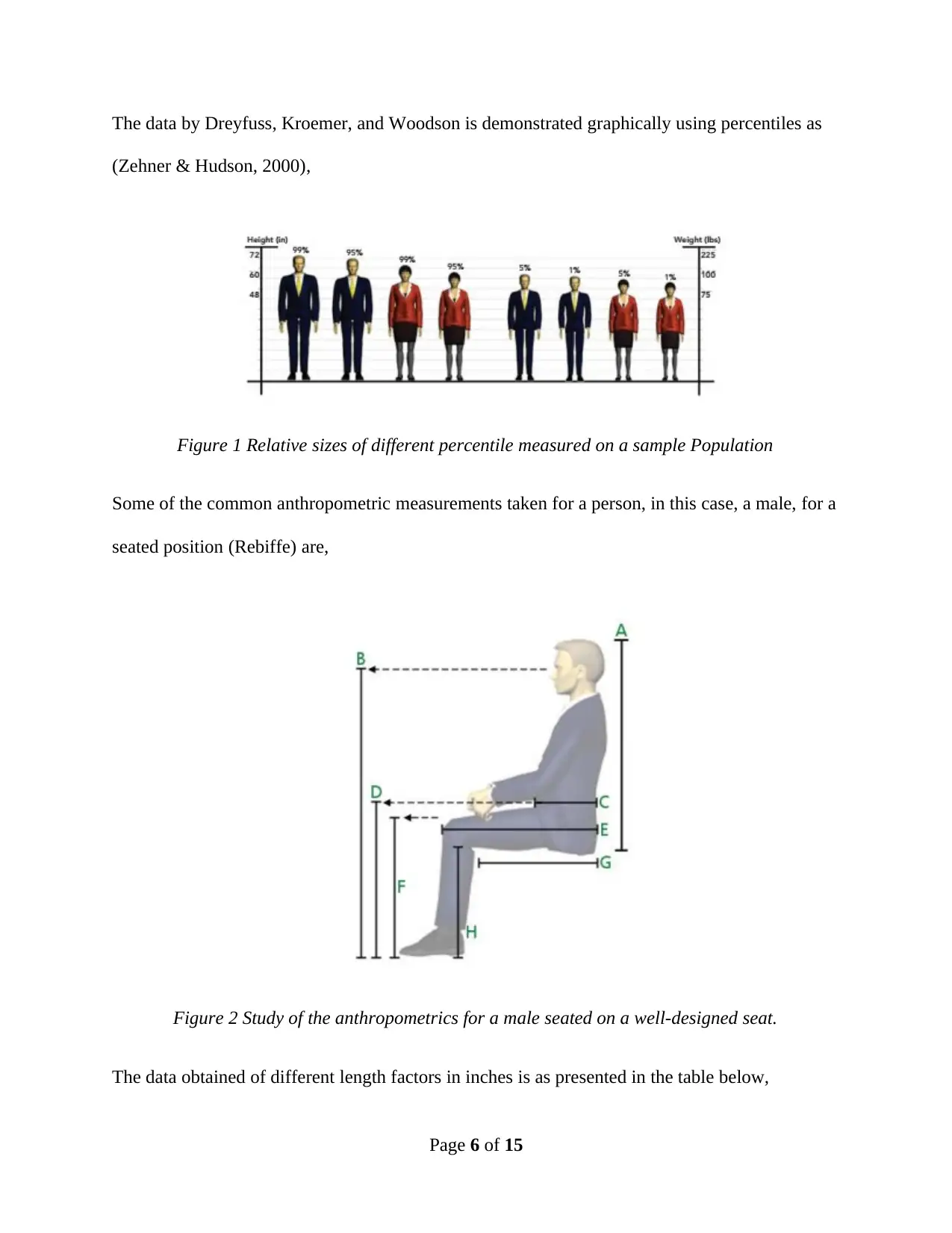
The data by Dreyfuss, Kroemer, and Woodson is demonstrated graphically using percentiles as
(Zehner & Hudson, 2000),
Figure 1 Relative sizes of different percentile measured on a sample Population
Some of the common anthropometric measurements taken for a person, in this case, a male, for a
seated position (Rebiffe) are,
Figure 2 Study of the anthropometrics for a male seated on a well-designed seat.
The data obtained of different length factors in inches is as presented in the table below,
Page 6 of 15
(Zehner & Hudson, 2000),
Figure 1 Relative sizes of different percentile measured on a sample Population
Some of the common anthropometric measurements taken for a person, in this case, a male, for a
seated position (Rebiffe) are,
Figure 2 Study of the anthropometrics for a male seated on a well-designed seat.
The data obtained of different length factors in inches is as presented in the table below,
Page 6 of 15
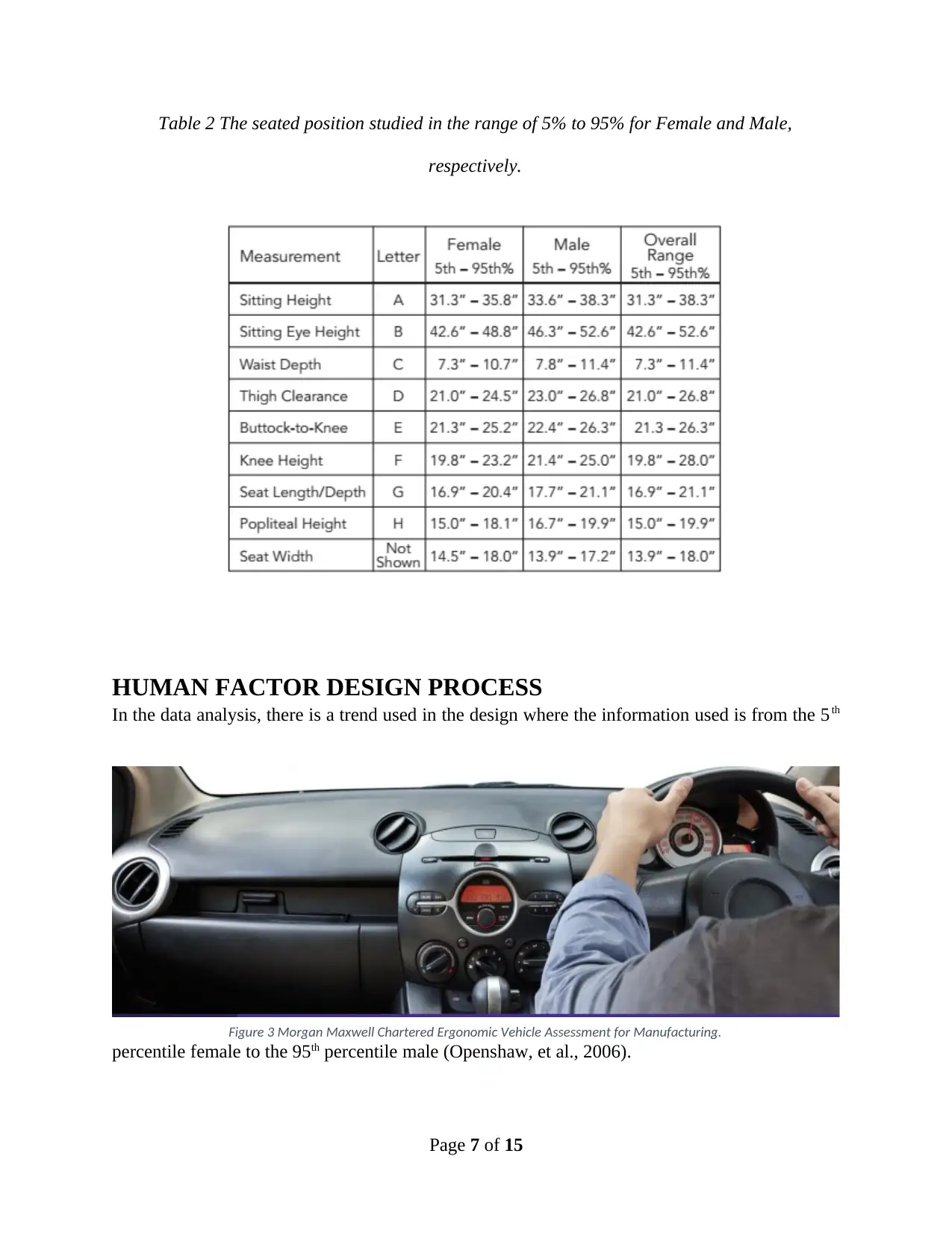
Table 2 The seated position studied in the range of 5% to 95% for Female and Male,
respectively.
HUMAN FACTOR DESIGN PROCESS
In the data analysis, there is a trend used in the design where the information used is from the 5 th
percentile female to the 95th percentile male (Openshaw, et al., 2006).
Page 7 of 15
Figure 3 Morgan Maxwell Chartered Ergonomic Vehicle Assessment for Manufacturing.
respectively.
HUMAN FACTOR DESIGN PROCESS
In the data analysis, there is a trend used in the design where the information used is from the 5 th
percentile female to the 95th percentile male (Openshaw, et al., 2006).
Page 7 of 15
Figure 3 Morgan Maxwell Chartered Ergonomic Vehicle Assessment for Manufacturing.
Paraphrase This Document
Need a fresh take? Get an instant paraphrase of this document with our AI Paraphraser
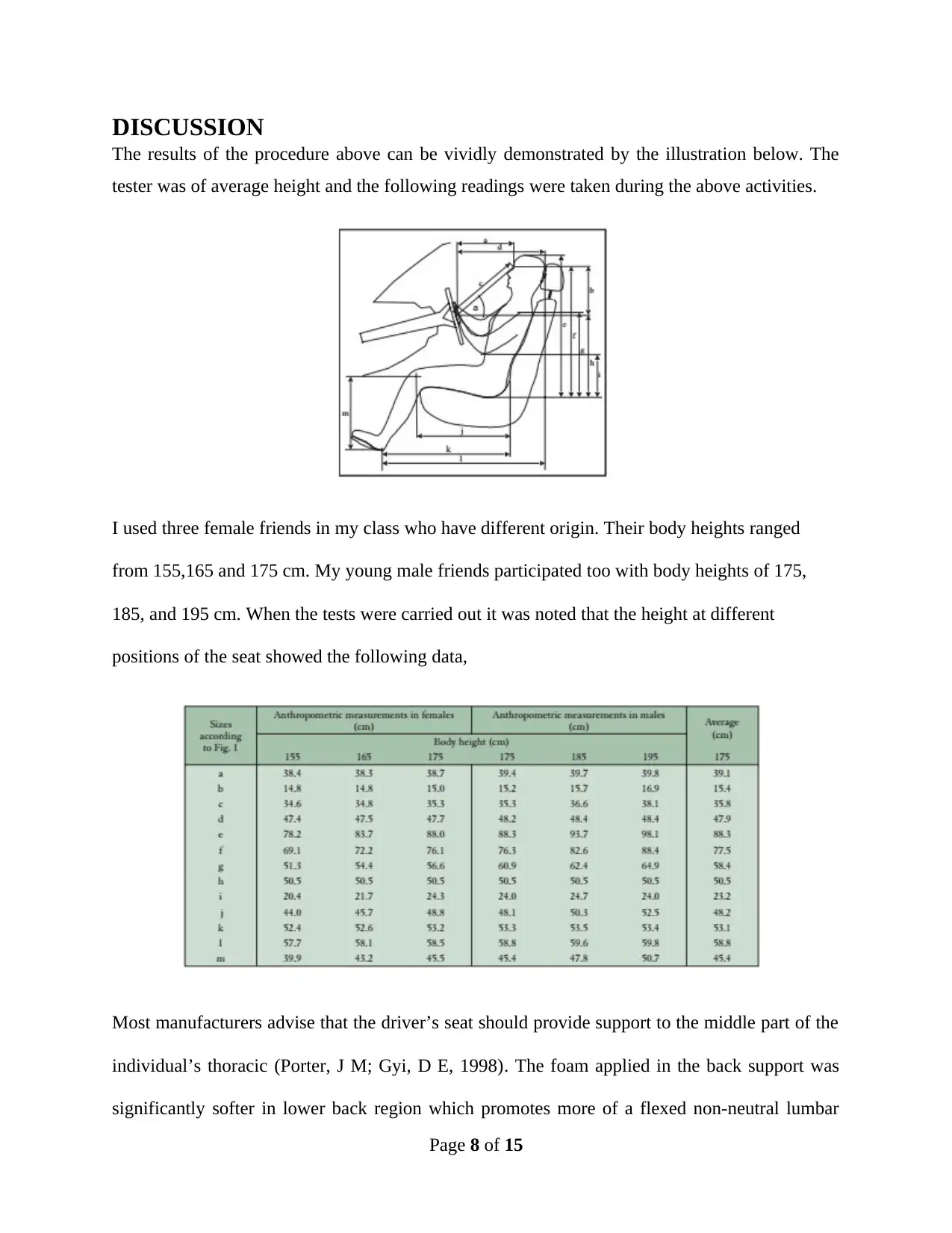
DISCUSSION
The results of the procedure above can be vividly demonstrated by the illustration below. The
tester was of average height and the following readings were taken during the above activities.
I used three female friends in my class who have different origin. Their body heights ranged
from 155,165 and 175 cm. My young male friends participated too with body heights of 175,
185, and 195 cm. When the tests were carried out it was noted that the height at different
positions of the seat showed the following data,
Most manufacturers advise that the driver’s seat should provide support to the middle part of the
individual’s thoracic (Porter, J M; Gyi, D E, 1998). The foam applied in the back support was
significantly softer in lower back region which promotes more of a flexed non-neutral lumbar
Page 8 of 15
The results of the procedure above can be vividly demonstrated by the illustration below. The
tester was of average height and the following readings were taken during the above activities.
I used three female friends in my class who have different origin. Their body heights ranged
from 155,165 and 175 cm. My young male friends participated too with body heights of 175,
185, and 195 cm. When the tests were carried out it was noted that the height at different
positions of the seat showed the following data,
Most manufacturers advise that the driver’s seat should provide support to the middle part of the
individual’s thoracic (Porter, J M; Gyi, D E, 1998). The foam applied in the back support was
significantly softer in lower back region which promotes more of a flexed non-neutral lumbar
Page 8 of 15
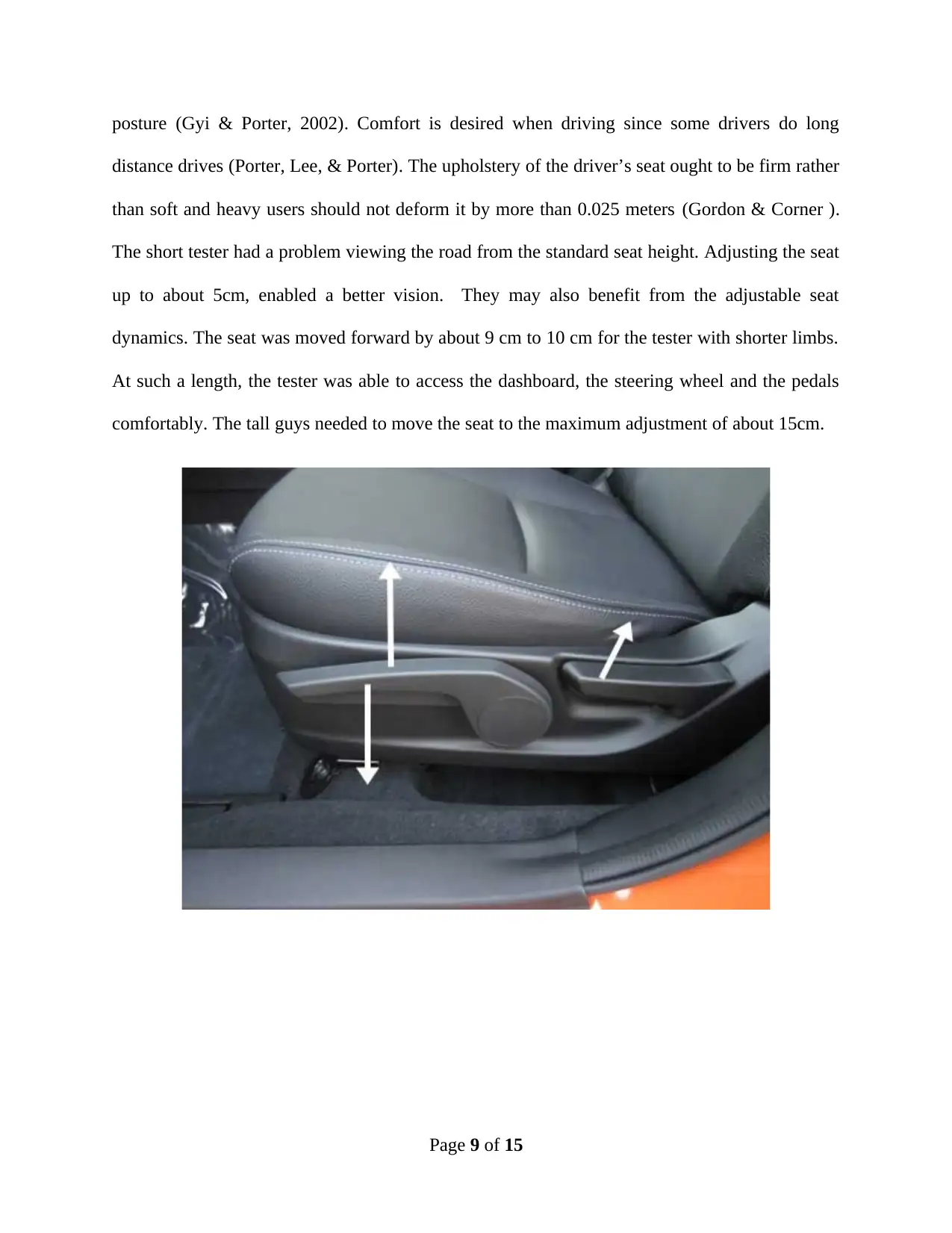
posture (Gyi & Porter, 2002). Comfort is desired when driving since some drivers do long
distance drives (Porter, Lee, & Porter). The upholstery of the driver’s seat ought to be firm rather
than soft and heavy users should not deform it by more than 0.025 meters (Gordon & Corner ).
The short tester had a problem viewing the road from the standard seat height. Adjusting the seat
up to about 5cm, enabled a better vision. They may also benefit from the adjustable seat
dynamics. The seat was moved forward by about 9 cm to 10 cm for the tester with shorter limbs.
At such a length, the tester was able to access the dashboard, the steering wheel and the pedals
comfortably. The tall guys needed to move the seat to the maximum adjustment of about 15cm.
Page 9 of 15
distance drives (Porter, Lee, & Porter). The upholstery of the driver’s seat ought to be firm rather
than soft and heavy users should not deform it by more than 0.025 meters (Gordon & Corner ).
The short tester had a problem viewing the road from the standard seat height. Adjusting the seat
up to about 5cm, enabled a better vision. They may also benefit from the adjustable seat
dynamics. The seat was moved forward by about 9 cm to 10 cm for the tester with shorter limbs.
At such a length, the tester was able to access the dashboard, the steering wheel and the pedals
comfortably. The tall guys needed to move the seat to the maximum adjustment of about 15cm.
Page 9 of 15
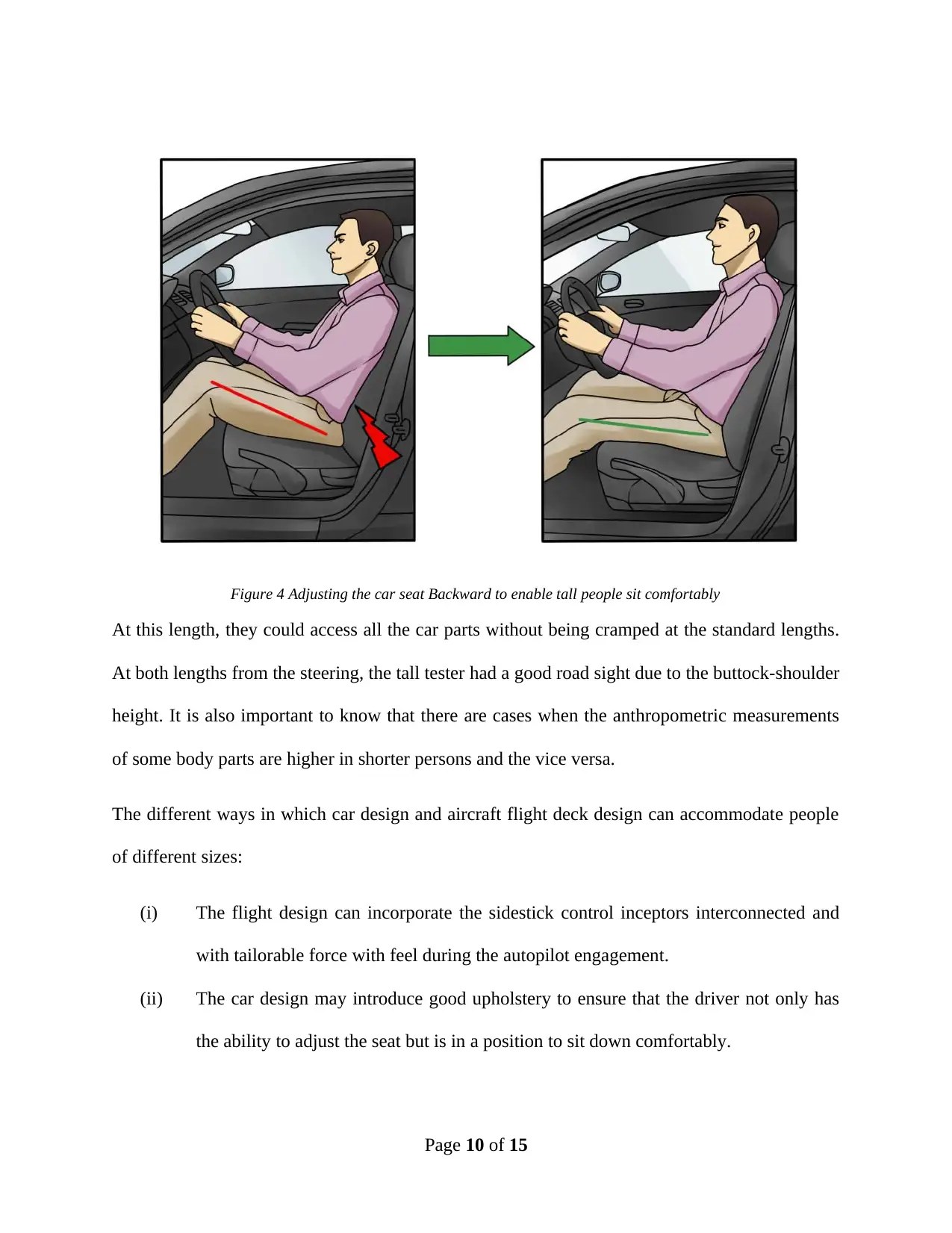
Figure 4 Adjusting the car seat Backward to enable tall people sit comfortably
At this length, they could access all the car parts without being cramped at the standard lengths.
At both lengths from the steering, the tall tester had a good road sight due to the buttock-shoulder
height. It is also important to know that there are cases when the anthropometric measurements
of some body parts are higher in shorter persons and the vice versa.
The different ways in which car design and aircraft flight deck design can accommodate people
of different sizes:
(i) The flight design can incorporate the sidestick control inceptors interconnected and
with tailorable force with feel during the autopilot engagement.
(ii) The car design may introduce good upholstery to ensure that the driver not only has
the ability to adjust the seat but is in a position to sit down comfortably.
Page 10 of 15
At this length, they could access all the car parts without being cramped at the standard lengths.
At both lengths from the steering, the tall tester had a good road sight due to the buttock-shoulder
height. It is also important to know that there are cases when the anthropometric measurements
of some body parts are higher in shorter persons and the vice versa.
The different ways in which car design and aircraft flight deck design can accommodate people
of different sizes:
(i) The flight design can incorporate the sidestick control inceptors interconnected and
with tailorable force with feel during the autopilot engagement.
(ii) The car design may introduce good upholstery to ensure that the driver not only has
the ability to adjust the seat but is in a position to sit down comfortably.
Page 10 of 15
Secure Best Marks with AI Grader
Need help grading? Try our AI Grader for instant feedback on your assignments.
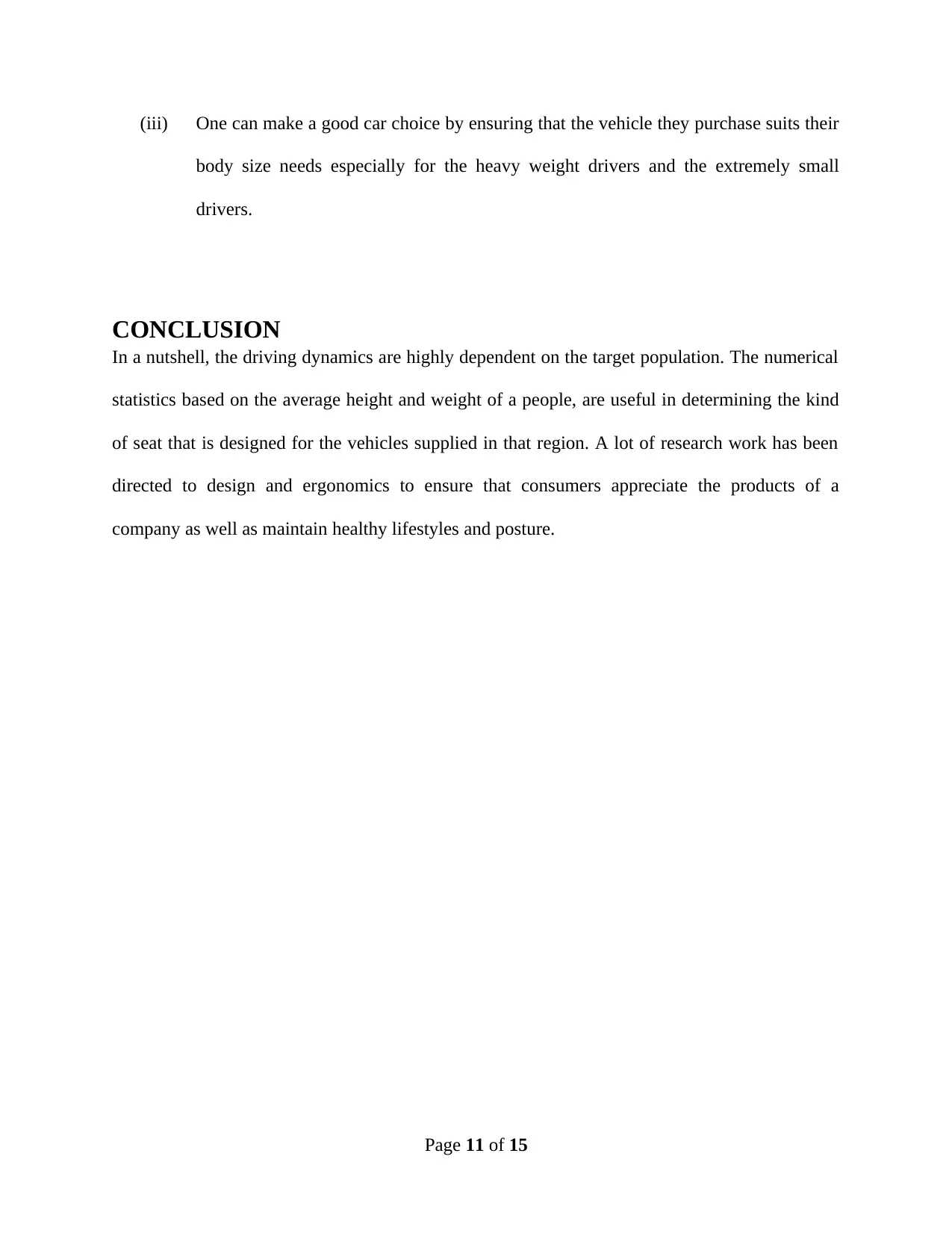
(iii) One can make a good car choice by ensuring that the vehicle they purchase suits their
body size needs especially for the heavy weight drivers and the extremely small
drivers.
CONCLUSION
In a nutshell, the driving dynamics are highly dependent on the target population. The numerical
statistics based on the average height and weight of a people, are useful in determining the kind
of seat that is designed for the vehicles supplied in that region. A lot of research work has been
directed to design and ergonomics to ensure that consumers appreciate the products of a
company as well as maintain healthy lifestyles and posture.
Page 11 of 15
body size needs especially for the heavy weight drivers and the extremely small
drivers.
CONCLUSION
In a nutshell, the driving dynamics are highly dependent on the target population. The numerical
statistics based on the average height and weight of a people, are useful in determining the kind
of seat that is designed for the vehicles supplied in that region. A lot of research work has been
directed to design and ergonomics to ensure that consumers appreciate the products of a
company as well as maintain healthy lifestyles and posture.
Page 11 of 15
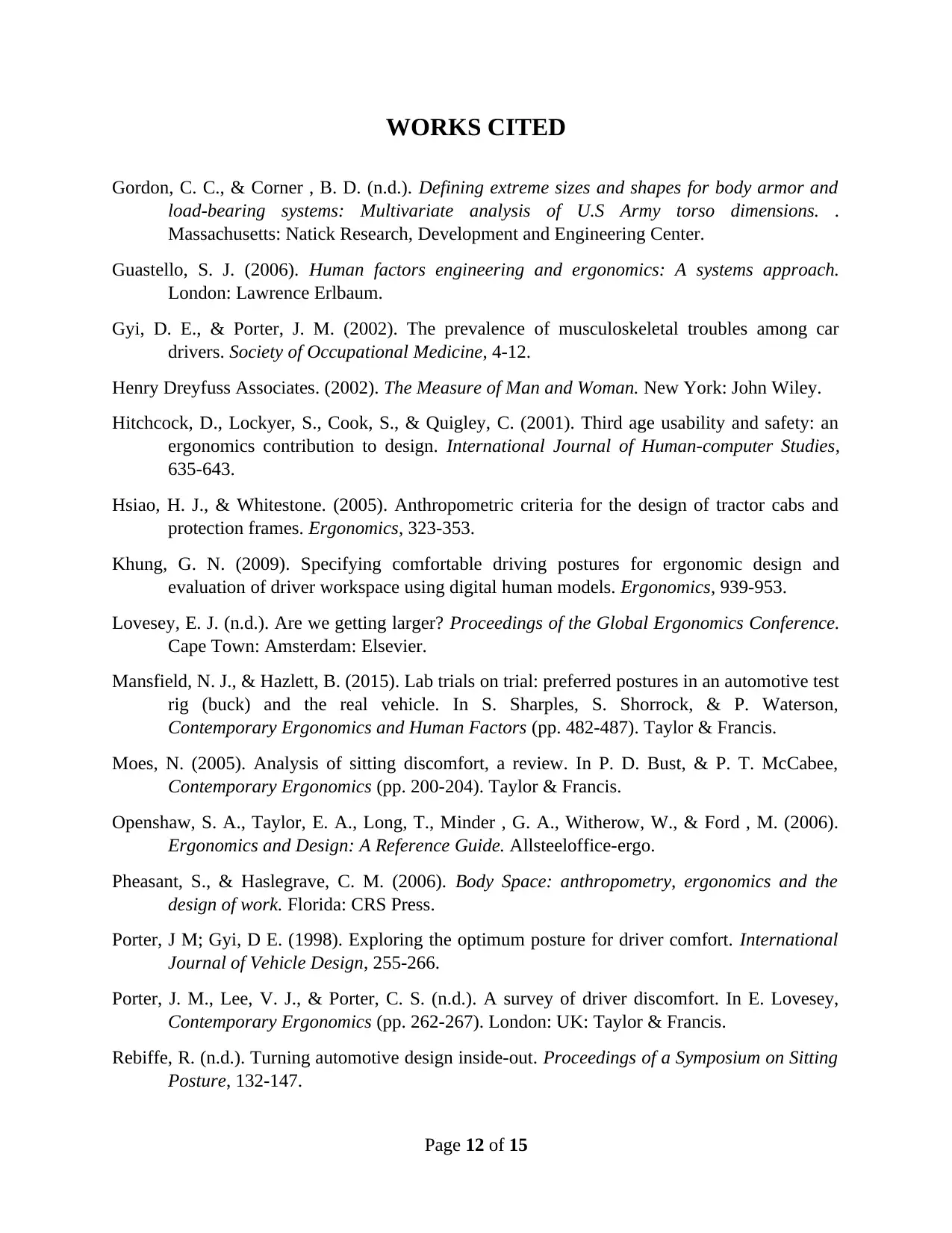
WORKS CITED
Gordon, C. C., & Corner , B. D. (n.d.). Defining extreme sizes and shapes for body armor and
load-bearing systems: Multivariate analysis of U.S Army torso dimensions. .
Massachusetts: Natick Research, Development and Engineering Center.
Guastello, S. J. (2006). Human factors engineering and ergonomics: A systems approach.
London: Lawrence Erlbaum.
Gyi, D. E., & Porter, J. M. (2002). The prevalence of musculoskeletal troubles among car
drivers. Society of Occupational Medicine, 4-12.
Henry Dreyfuss Associates. (2002). The Measure of Man and Woman. New York: John Wiley.
Hitchcock, D., Lockyer, S., Cook, S., & Quigley, C. (2001). Third age usability and safety: an
ergonomics contribution to design. International Journal of Human-computer Studies,
635-643.
Hsiao, H. J., & Whitestone. (2005). Anthropometric criteria for the design of tractor cabs and
protection frames. Ergonomics, 323-353.
Khung, G. N. (2009). Specifying comfortable driving postures for ergonomic design and
evaluation of driver workspace using digital human models. Ergonomics, 939-953.
Lovesey, E. J. (n.d.). Are we getting larger? Proceedings of the Global Ergonomics Conference.
Cape Town: Amsterdam: Elsevier.
Mansfield, N. J., & Hazlett, B. (2015). Lab trials on trial: preferred postures in an automotive test
rig (buck) and the real vehicle. In S. Sharples, S. Shorrock, & P. Waterson,
Contemporary Ergonomics and Human Factors (pp. 482-487). Taylor & Francis.
Moes, N. (2005). Analysis of sitting discomfort, a review. In P. D. Bust, & P. T. McCabee,
Contemporary Ergonomics (pp. 200-204). Taylor & Francis.
Openshaw, S. A., Taylor, E. A., Long, T., Minder , G. A., Witherow, W., & Ford , M. (2006).
Ergonomics and Design: A Reference Guide. Allsteeloffice-ergo.
Pheasant, S., & Haslegrave, C. M. (2006). Body Space: anthropometry, ergonomics and the
design of work. Florida: CRS Press.
Porter, J M; Gyi, D E. (1998). Exploring the optimum posture for driver comfort. International
Journal of Vehicle Design, 255-266.
Porter, J. M., Lee, V. J., & Porter, C. S. (n.d.). A survey of driver discomfort. In E. Lovesey,
Contemporary Ergonomics (pp. 262-267). London: UK: Taylor & Francis.
Rebiffe, R. (n.d.). Turning automotive design inside-out. Proceedings of a Symposium on Sitting
Posture, 132-147.
Page 12 of 15
Gordon, C. C., & Corner , B. D. (n.d.). Defining extreme sizes and shapes for body armor and
load-bearing systems: Multivariate analysis of U.S Army torso dimensions. .
Massachusetts: Natick Research, Development and Engineering Center.
Guastello, S. J. (2006). Human factors engineering and ergonomics: A systems approach.
London: Lawrence Erlbaum.
Gyi, D. E., & Porter, J. M. (2002). The prevalence of musculoskeletal troubles among car
drivers. Society of Occupational Medicine, 4-12.
Henry Dreyfuss Associates. (2002). The Measure of Man and Woman. New York: John Wiley.
Hitchcock, D., Lockyer, S., Cook, S., & Quigley, C. (2001). Third age usability and safety: an
ergonomics contribution to design. International Journal of Human-computer Studies,
635-643.
Hsiao, H. J., & Whitestone. (2005). Anthropometric criteria for the design of tractor cabs and
protection frames. Ergonomics, 323-353.
Khung, G. N. (2009). Specifying comfortable driving postures for ergonomic design and
evaluation of driver workspace using digital human models. Ergonomics, 939-953.
Lovesey, E. J. (n.d.). Are we getting larger? Proceedings of the Global Ergonomics Conference.
Cape Town: Amsterdam: Elsevier.
Mansfield, N. J., & Hazlett, B. (2015). Lab trials on trial: preferred postures in an automotive test
rig (buck) and the real vehicle. In S. Sharples, S. Shorrock, & P. Waterson,
Contemporary Ergonomics and Human Factors (pp. 482-487). Taylor & Francis.
Moes, N. (2005). Analysis of sitting discomfort, a review. In P. D. Bust, & P. T. McCabee,
Contemporary Ergonomics (pp. 200-204). Taylor & Francis.
Openshaw, S. A., Taylor, E. A., Long, T., Minder , G. A., Witherow, W., & Ford , M. (2006).
Ergonomics and Design: A Reference Guide. Allsteeloffice-ergo.
Pheasant, S., & Haslegrave, C. M. (2006). Body Space: anthropometry, ergonomics and the
design of work. Florida: CRS Press.
Porter, J M; Gyi, D E. (1998). Exploring the optimum posture for driver comfort. International
Journal of Vehicle Design, 255-266.
Porter, J. M., Lee, V. J., & Porter, C. S. (n.d.). A survey of driver discomfort. In E. Lovesey,
Contemporary Ergonomics (pp. 262-267). London: UK: Taylor & Francis.
Rebiffe, R. (n.d.). Turning automotive design inside-out. Proceedings of a Symposium on Sitting
Posture, 132-147.
Page 12 of 15
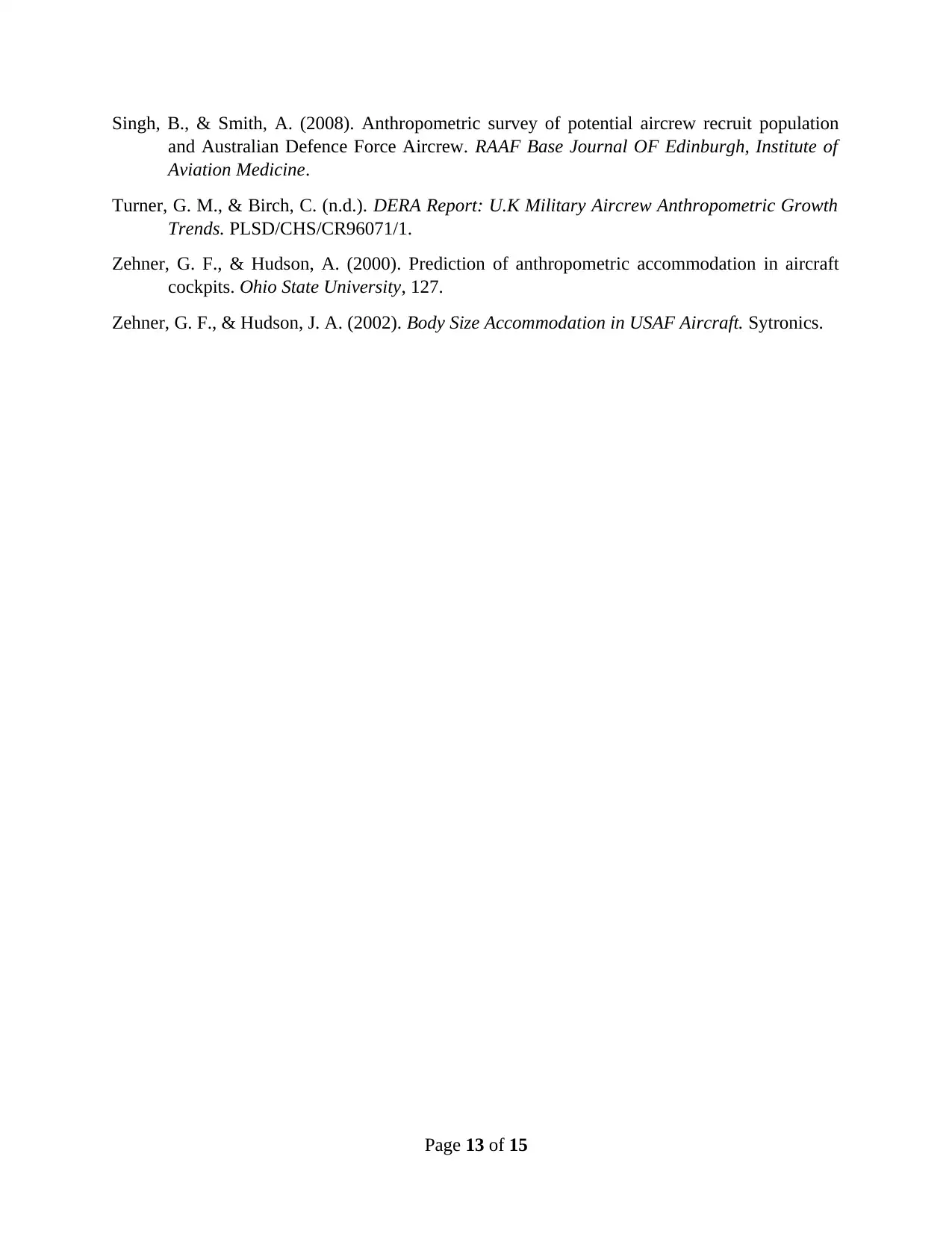
Singh, B., & Smith, A. (2008). Anthropometric survey of potential aircrew recruit population
and Australian Defence Force Aircrew. RAAF Base Journal OF Edinburgh, Institute of
Aviation Medicine.
Turner, G. M., & Birch, C. (n.d.). DERA Report: U.K Military Aircrew Anthropometric Growth
Trends. PLSD/CHS/CR96071/1.
Zehner, G. F., & Hudson, A. (2000). Prediction of anthropometric accommodation in aircraft
cockpits. Ohio State University, 127.
Zehner, G. F., & Hudson, J. A. (2002). Body Size Accommodation in USAF Aircraft. Sytronics.
Page 13 of 15
and Australian Defence Force Aircrew. RAAF Base Journal OF Edinburgh, Institute of
Aviation Medicine.
Turner, G. M., & Birch, C. (n.d.). DERA Report: U.K Military Aircrew Anthropometric Growth
Trends. PLSD/CHS/CR96071/1.
Zehner, G. F., & Hudson, A. (2000). Prediction of anthropometric accommodation in aircraft
cockpits. Ohio State University, 127.
Zehner, G. F., & Hudson, J. A. (2002). Body Size Accommodation in USAF Aircraft. Sytronics.
Page 13 of 15
Paraphrase This Document
Need a fresh take? Get an instant paraphrase of this document with our AI Paraphraser

Page 14 of 15
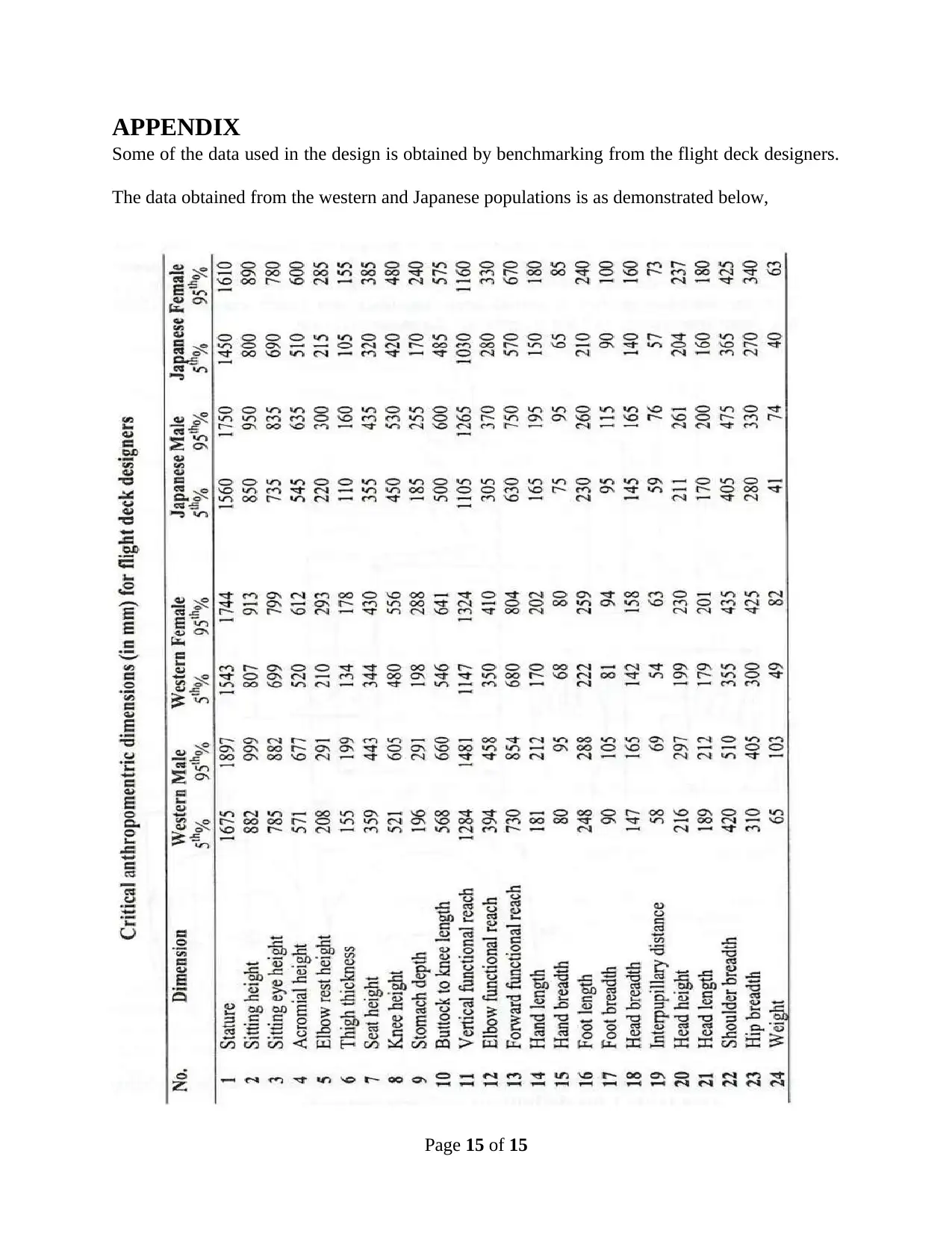
APPENDIX
Some of the data used in the design is obtained by benchmarking from the flight deck designers.
The data obtained from the western and Japanese populations is as demonstrated below,
Page 15 of 15
Some of the data used in the design is obtained by benchmarking from the flight deck designers.
The data obtained from the western and Japanese populations is as demonstrated below,
Page 15 of 15
1 out of 15
Your All-in-One AI-Powered Toolkit for Academic Success.
+13062052269
info@desklib.com
Available 24*7 on WhatsApp / Email
![[object Object]](/_next/static/media/star-bottom.7253800d.svg)
Unlock your academic potential
© 2024 | Zucol Services PVT LTD | All rights reserved.